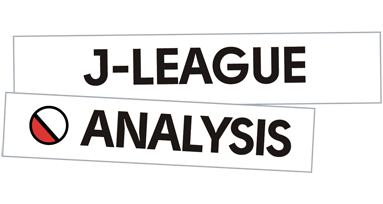Last weekend’s tight J-League match-up saw a third-place FC Tokyo play hosts to the 2019 champions, Yokohoma FM at the Ajinomoto stadium. Having lost 1-0 to Yokohoma FC during the week, FC Tokyo were looking to avoid their first back-to-back defeat since December 2018. Whilst having plenty of firepower in the shed, it would be the Marinos’ defence that would come under inspection as only four teams have conceded more goals this season. Having said that, with a 2-1 win over Nagoya mid-week, Ange Postecoglou will feel like his side can secure a result and move a step closer to Asian Champions League qualifiers.
This tactical analysis will delve deep into the different tactics that Kenta Hasegawa and Ange Postecoglou used to try and overcome each other’s sides. This analysis will also highlight how both teams were able to create and capitalise on their goal-scoring opportunities.
Lineups
The home side lined up in a 4-4-2 formation which remained consistent throughout the match. Number 33, Akihiro Hayashi started between the sticks with Ryoya Ogawa, Masato Morishige, Tsuyoshi Watanabe, and Takumi Nakamura as the back four. Shuto Abe and Arthur Silva positioned themselves centrally to provide the linking role between defence and attack. Kyosuke Tagawa and Hirotaka Mita pushed out on the flanks to stretch the opposition whilst Deigo Oliveira and Kensuke Nagai were the strikeforce up front.
As for Postecoglou’s side, they shifted to a 4-2-3-1 formation which came with two obvious benefits. The first was that having two defensive midfielders bolstered their defence and were able to step in if one of the back four got dragged out of position. The second was having Marcos Junior more centrally, higher up the pitch allowed him the space needed to create attacking opportunities.
Starting as keeper for the Marinos was Il-Kyu Park with Shinnosuke Hatanaka and Makito Ito as the centre-back pairing. Theerathon Bunmathan and Ken Matsubara held their positions out wide as attacking full-backs. Takahiro Ogihara and Takuya Kida sat in front of the backline to protect the defensive line. Marcos Junior was given the freedom as the central attacking midfielder and looked to link up with Erick, Junior Santos, and Dazien Maeda up front.
Narrowing the full-backs
In typical Marinos fashion, we saw the different variations that full-backs, Bunmathan and Matsubara, provided during phases of possession. During the build-up, both full-backs would position themselves either close to the centre-backs or behind the first line of defence next to the defensive midfielders. By doing this, it would allow for either Kida or Ogihara to push up next to Marcos Junior whilst Maeda and Erick dropped to provide wide support for the centre-backs.
Whilst we are familiar with the benefits of having narrow full-backs in possession (just think of the full-backs in Guardiola’s title-winning Manchester City and Bayern Munich sides), they are also able to provide structural stability in transitional moments.
Below is an example where the narrowing of full-backs provides defensive stability during transitions. In an attempt to find Junior Santos off a cross from out wide, the ball is intercepted and falls to the FC Tokyo midfielder where he has space to turn and progress forwards.
However, because of the short distance between the player on the ball and Bunmathan, the Thai full-back is able to immediately react and influence the player on the ball. This allows both defensive midfielders, Ogihara and Kida, to drop and prevent the ball from finding the FC Tokyo forwards. However, whilst Yokohoma remain secure centrally, the downfall comes from the opponent combining to get the ball into wide areas where there is no full-back.
Once winning the ball, FC Tokyo is able to bypass the immediate Marinos press and find one of their high players. Because of Bunmathan stepping into midfield to win the ball back, he then leaves the left side free for the full-back to exploit. Fortunately for the Marinos, this situation occurs in the opponent’s half, allowing the backline to drop deeper and the defensive midfielders to cover other forward runners. Once they are secure in their low block, if the full-backs haven’t got back in time, the centre-backs step out whilst the defensive midfielders cover centrally as seen below.
Although Yokohoma are now secure ball side, the far-side players need to think about what would happen if the wide player on the ball could cross in. In this situation, it could leave a 2 v 1 at the back post so the far-side full-back needs to recognise and adjust to the speed of the ball mid-flight. This will influence who he will need to pick up in a 2 v 1 situation.
Creating opportunities from low possession
Throughout the game, FC Tokyo found themselves with a lack of ball possession and time on the ball. A style of football that Postecoglou insists on is where his team looks to win the ball as quickly as possible. On average, Yokohoma had a much lower PPDA (Passes allowed per defensive action, indicating how quickly a team wins the ball back) than FC Tokyo with 6.1 PPDA compared to 17.1 PPDA. This meant that the defending champions had the ball for longer and won it back quickly after they lost it. Therefore, Hasegawa needed to find a way to limit the threat of being countered in dangerous areas
In an effort to protect their defence as much as possible, FC Tokyo looked to attack down the flanks with quick passing after they had gained possession. That way if they did lose the ball, it would be away from the box and the heart of the defence. This can be seen in the data set below, showing where FC Tokyo lost the ball.
After moving the ball out wide, FC Tokyo ended up losing the ball by playing longer passes to either winger or crossing into their strikers up front. Although the turnover of possession was quick, the distance of the attempted pass means that the ball carrier doesn’t need to travel as far to get back into a defensive shape.
Above is an example of this. After winning the ball back, Tagawa receives the ball off a long pass from the back like. Although numerically disadvantaged, having a player with space to drive forward provides a rare attacking opportunity for FC Tokyo to take advantage of. In the event where Tagawa loses the ball out wide, there are still numbers behind the ball, so they are able to set their rest defence. The emphasis for goal-scoring opportunities is then placed on wingers, Mita and Tagawa, to make long counter-attacking runs forward and provide service to Oliveira and Nagai.
Breaking the backline
During quick succession, the Marinos finally broke the defensive line of FC Tokyo within the space of three minutes during the second half. One of the commonalities between both goals (aside from the goals scorer, Junior Santos), was Yokohoma’s ability to get players in front of the opposition defensive line to take defenders on 1 v 1.
After receiving the ball which broke two lines of defence, Marcos Junior recognises the supporting run of Erick out wide and plays his early. This scenario has now turned into a 1 v 1 duel between Erick and Ogawa.
Knowing Erick will beat him for pace, Ogawa drops and looks to influence the Brazilian closer to the box. At the same time, Junior Santos is making his supporting run on the inside of the far-side full-back. Ogawa needs to ensure at this point that Erick remains wide and isn’t afforded the opportunity to cut inside. One of the mistakes made by the FC Tokyo centre-backs at this point is that they haven’t fully accelerated to get back and eventually support Ogawa. They reach full speed once Erick has received the ball beyond their line.
Up until this point, Ogawa has done his job and kept Erick wide. However, due to individual skill, Erick was able to shake off Ogawa and cut inside. The rest of Tokyo’s backline is still running back to try and get into position. Morishige provides second man cover but an error is made by Watanabe. Instead of dropping to cover the space behind Morishige (whilst keeping an eye on the run of Junior Santos), he makes a move into the path of the Brazilian striker, as to block his run. This does not work and the Marinos have their first goal.
In similar fashion to the first goal, the next was a tap in for Junior Santos. However, this goal can be attributed to quick counter-pressing and winning 50/50 battles for the ball. The poor individual defensive marking did not help Tokyo either.
In the lead-up to Marcos Junior keeping the ball, FC Tokyo had three opportunities to recover the ball in 50/50 plays. What made Yokohoma keep possession was the use of their bodies to shield the ball and keep their marker away. Even when Marcos Junior plays the straight ball into Maeda, Watanabe still has the opportunity to make the tackle and win the ball back but is unable to. Luckily for the Brazilian, the ball bobbles to his feet where he can get a clear shot on goal.
In the seconds leading up to that goal, one of the moments that stood out was the slow reaction of Tokyo’s full-back, Nakamura, to retreat early and reconnect with the centre-backs. During the 50/50 moments in the lead up to the goal, that is when Nakamura needed to anticipate the potential loss of possession and drop into a half-and-half position closer to his centre-backs. That way when they did lose the ball, he would have a shorter distance to run and pick up Junior Santos at the back post.
Conclusion
This tactical analysis highlighted the tactics used by both teams and showed how Yokohoma’s pace of play was too good for FC Tokyo this time around. Despite clear cut chances within the first half, Tokyo were not able to capitalise. Through dominating possession and intense pressing, the Marinos came away with a 4-0 win.
With back-to-back losses, that pushes FC Tokyo out of third position where Gamba Osaka now take over. Despite registering back to back wins, the Marinos are still sitting in seventh position, but only four points behind Gamba Osaka. With plenty more rounds in the 2020 season, Yokohoma still have a chance of qualifying for Asia’s Champions League.
















